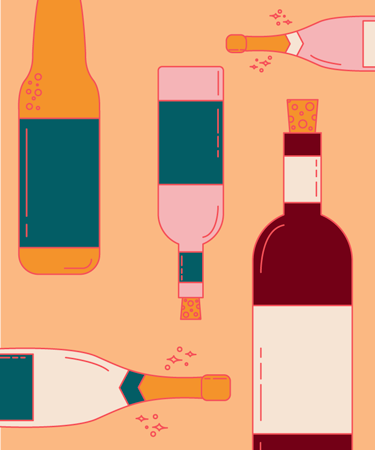
The mastering of food and wine pairing is not based on science alone; it requires a creative mentality, sensitive palate, and broad understanding of the complex tastes that both food and wine can offer, especially when their forces are combined. Not sure where to begin? When in doubt, regional pairings are a safe place to start. Full-bodied Malbec with Argentinian steaks, German beer with spicy bratwurst, and, most certainly, white truffles with a hearty Barolo. When a food and wine that hail from the same region are served side by side, their mutual terroir is highlighted to a brand new level of sensorial delight. Never experienced this type of gastronomical pleasure? Barolo and Piemontese truffles are a surefire place to start.
Barolo, the robust red of Piedmont, presents a powerful, rustic palate of cherry and spices. The intense flavor profiles of the wine rely on equally strong food flavors to complement its heartiness, making truffles a perfect match. So what exactly is a truffle? Truffles are a type of fungi associated with roots and trees. Their flavors are generally earthy and garlicky, with a strong, funky odor — in the best way. Like mushrooms? You’ll love truffles.
White truffles, otherwise known as Alba truffles, are generally found in the Alba, Langhe, and Monferrato regions of Piedmont. White truffles range in color from creamy beige to hues of brown and are generally the highest-regarded species of truffle. Due to their strong, pungent flavors, they are used sparingly in cooking, frequently shaved atop a dish of fresh pasta, served in cheese, or thinly sliced into roasting meats. A dish including Alba truffles screams for a rugged, muscular bottle of red to complement its powerful flavors. As Danilo Drocco, winemaker at Fontanafredda winery in Piedmont, explains: “In the fall, there is no more divine combination than white truffles and Barolo! The famous Alba white truffle is one of the world’s most prized delicacies and Barolo is the classic wine accompaniment, as it mirrors and draws out its earthy and gamey quality.” He suggests that Barolo “is an incredible wine that should be matched with dishes of equal value, but which is so great that it is capable of enhancing any food.”

For a food expert’s opinion, we asked Fitz Tallon, executive chef of Eataly NYC Flatiron, why he thinks Barolo and truffles work so well. “Barolo and truffles work so well together because it matches power with power,” he said. “Mild flavors will easily be overwhelmed by a robust Barolo, so it’s best to pair this wine with foods that are able to stand up to the challenge, as truffles are.”
Intrigued by this flawless food-and-wine pairing yet not sure where to start? Simply shaving some white truffle on top of your next pasta dish is a great introductory way to experience the magic of truffles. You could also check the counter of your local cheese shop to see if there are any truffle-infused options available, discovering the wonder that the spicy addition brings to a sharp block of cheese. Unable to find truffles? Truffle oil is a great backup, both easily accessible and more affordable than truffles themselves. Drizzle over pizza, pasta, or grilled vegetables for amplified gastronomical experiences. Or, take Fitz Tallon’s advice: “I love making Carne Cruda with Toro Ranch Piemontese beef, extra virgin olive oil, sea salt, and shaved white truffles because it is a dish that perfectly shows how elegant food can be when the ingredients are left to shine.”
Any of these truffle options will sparkle alongside a bottle of Barolo; as Danilo says, “Every time you open a bottle of Barolo, it can give you unique emotions and sensations. Barolo is an important, austere and precious wine, recognized by the experts as one of the best in the world; but don’t be intimidated by its fame and remember: you don’t need a special occasion to enjoy it. You can share it with your family or friends at home or during a party. Don’t let somebody else drink your Barolo.” We most certainly will not.
Recipes:
Cardo con fonduto e tartufo d’alba
For 6 people
For the cardoons (white cardoons):
- 3 “cardi gobbi di Nizza” (the heart)
- 5g butter
- 1 lemon
- Salt
For the fondue:
- 200g Castelmagno cheese
- ¼ cup whole milk
- 3 egg yolks
- White truffle from Alba
For the cardoons:
- In a large pot, parboil the cardoons in salted water with lemon juice for about 4-5 minutes. Drain the cardoons.
For the fondue:
Heat the milk. Add the diced Castelmagno cheese, stirring continuously, careful not to boil. Stir until the cheese is completely melted. Add the egg yolks and cook for another 3-4 minutes over low heat. Keep the fondue warm in a double boiler. In the meantime, cut the cardoons into sections. Cook them over low heat in a pan with butter for 2 minutes on both sides, then lay them on a serving plate. Cover the cardoons with the fondue and top with finely-sliced white truffle.
Agnolotti di Lidia
For 6 people
For the filling:
- 1 carrot
- 1 onion
- 150g of pork loin
- 200g of Carmagnola grey rabbit meat
- 200g veal shoulder
- 200g of green escarole
- 100g of spinach
- 4 eggs
- 50g Parmigiano Reggiano cheese
- 20g of butter
- 50cl of extra-virgin olive oil
- salt and pepper
For the pasta:
- 500g of plain flour
- 11 egg yolks
- 3-4 cups of cold water
- small amount of cornmeal flour
For the filling:
Gently fry the chopped carrot and onion in olive oil. Add the pork loin and rabbit, searing them over a high heat until golden. Turn down the heat and continue cooking. When about halfway done, add the veal shoulder, escarole and spinach. Cover and cook for at least two hours. Leave to cool. Meanwhile, reduce the cooking juices, strain and set aside in a small pan. Chop the meat finely. Add the eggs and the grated parmesan to the mixture, adding salt and pepper to taste.
For the pasta:
Sieve the flour into a mound on the pastry board and make a shallow hole in the middle. Drop the egg yolks and water into the hole. Knead vigorously into a smooth, even dough. Cover it with a damp cloth and leave it to rest for about half an hour. Break off a piece and roll it through a pasta maker, inserting the thickest end fist. When the sheet of pasta is ready, lay it on the pastry board and place little spoonfuls of filling along one side, spacing them 2-3 cm apart. Fold the pasta sheet in half to cover the mounds of filling and press down firmly around them. Use a pasta cutting wheel to cut the row of “agnolotti” down the length of the pasta sheet, then cut across to separate them. Now seal the “agnolotti” one by one with a pinch, known locally as the “plin.” Lay them on a cloth sprinkled lightly with cornmeal flour until ready to cook. Cook the “agnolotti” in boiling water for about a minute and a half, drain and toss in the roasted meat juices set aside earlier with some butter.
Costine di maile e fagioli zolfini
For 6 people
For the spare ribs:
- 18 pork spare ribs (the central part)
- Rosemary
- Extra virgin olive oil
- Salt
For the beans:
- 400g dried Zolfini beans
- One-half red onion
- 40g flour
- 100g tomato puree
- 1lt vegetable stock
- 1 medium-sized potato
- 50 g extra-virgin olive oil
For the ribs:
- Slowly roast the ribs in a pot with olive oil and rosemary. Cover the pot tightly and place in the preheated oven at 175 degrees for 6 hours.
For the beans:
Soak them in a bowl of cold water for 12 hours. Drain the beans and mix with flour and tomato puree. Over low heat cook the onion in olive oil, then add the beans. Cover with some of the vegetable stock and cook them together with the finely chopped potato. Let this all cook until it becomes like creamy soup. When the ribs are cooked, take them out of the oven, roast them for five minutes, add salt. Place them over a bed of aromatic herbs next to a bowl of the creamy bean soup.
This article is brought to you by Barolo Week, sponsored by Fontanafredda, an iconic Barolo producer founded by the first king of Italy.
